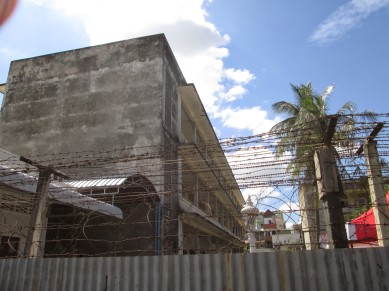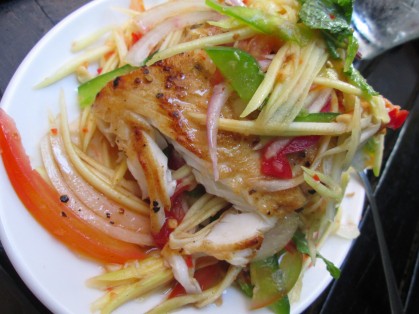 Toto, I have a feeling we’re not in Bangkok anymore. Nope, now in Phnom Penh, Cambodia, previously called “Kampuchea.” Compared to cosmopolitan all-things-to-all-people Bangkok, Phnom Penh is sort of modest.
Toto, I have a feeling we’re not in Bangkok anymore. Nope, now in Phnom Penh, Cambodia, previously called “Kampuchea.” Compared to cosmopolitan all-things-to-all-people Bangkok, Phnom Penh is sort of modest.
I don’t actually know the numbers but guessing there are two skyscrapers (somewhere), no large boulevards, few traffic lights, fewer sidewalks, 36 ipods, one mall. People are moving but not in that urban urgent way. The flashiest part of town is accessible to mere mortals. Not much here is dramatically historic or dramatically beautiful. And none of this is surprising. Phnom Penh has had a lot of catching up to do. In the few years before Meredith and Graham were born (to provide some perspective), Phnom Penh was pretty much destroyed, and all of Cambodia is still recovering from one of the world’s worst genocides.
In 1975, the Khmer Rouge staged a successful communist take-over in Cambodia that in the subsequent four years was responsible for deaths of an estimated 3 million people. The government destroyed many of Cambodia’s most treasured Buddhist temples and historic sites, as well as much of its tradition and culture. The political environment that permitted this tragedy is complicated and involves both the US and China. Some of the story is presented in the Oscar-winning movie, “The Killing Fields.”
Almost forty years later, there is still plenty of struggle and poverty, but Cambodians have made a lot of progress. In the past few years, commercial investment has increased substantially, and there have been significant improvements in education, health care and roads. For tourists, there are a lot of very cool places to eat, great accommodations of all types, gorgeous boutiques of textiles and crafts, and some good museums. And there is a feeling that things are going to be better.
On my first morning, I started where I usually start in a new city– at museums. The National Museum has some amazing statues and some art but it does not provide much insight into the country’s history or culture. Photography is not permitted in the museum but the building itself is a gorgeous example of Khmer architecture (Khmers are an ethnic group that makes up 90% of Cambodia’s population).
After the museum I hopped a tuck-tuck to Tuol Sleng, which is a former high school the Khmer Rouge used as a prison and torture center during its reign of terror. I joined a guided tour and heard stories that were just unimaginable. Of 10,000 detainees, only 7 survived.
And then comes the food foraging. Phnom Penh has many many “NGOs” — nonprofits that serve communities in need — and one of the things they do very well is manage restaurants that provide job training grounds for local youth. The food in these restaurants tends to be very healthy and I hope to eat at several of these types of restaurants while I am in Phnom Penh.
Day 2 — less polite tourism, more of a clusterfuck. I got up early to go to Koh Dach, an island in the middle of the Mekong River about 12 miles north of the city that is famous for its silk textile weavers. My hotel manager helped me engage a “remork” (tuk tuk) who agreed to drop me off at the ferry dock and wait two hours for me to return. I started to have concerns when the driver took us to a ferry that was not mentioned in the Lonely Planet book. He assured me this was was the best way to go because it was shorter than the route I was expecting.

If you are going to overload an 80 year old ferry, you might as well have a 15 year old skipper taking it across the river.

This ferry looked a lot like the ones you see on the evening news so I positioned myself away from the cars and close to the 4 life preservers.
From there, the driver headed directly to his friend’s textile store in the middle of I don’t know where, even after I told him he seemed to be going the wrong direction. When I realized what he had done, I told him he had compromised my safety and I no longer trusted him. He was apologetic and said he would take me to the ferry that would land at Koh Dach. We drove another 40 minutes through a remote and beautiful jungle, although I wasn’t focusing much on the beautiful part.

This was our gas station in the middle of the jungle. Those glass coke bottles on the rickety table next to the little boy are filled with gas.
I left the driver at the ferry and told him I would find my way back. Stepping off the ferry, I realized I was not at the port where I told the driver to take me. I was in the middle of no where (I learned later, about 6 miles from where I was supposed to be) with no public transportation of any kind and I was not feeling very jai yen about it.
During the next 20 minutes of walking, I considered whether I was an idiot to trust a tuk-tuk driver or just a spoiled American expecting everything to be so easy, or both, probably both. Before the internal conversation got too metaphysical, I came upon a small bed and breakfast and was grateful to see a man and woman in the yard who looked like they might speak English. I briefly introduced myself and explained what had happened. Robert and Do, the married owners, speak Khmer, French and Spanish but not English. I shifted to speaking fake French while they spoke broken English. What wonderful people — Robert gave me a bottle of water and explained that the weavers on the island were pretty much gone. Do fired up her motorbike and I had a super fun ride to the ferry that would connect me to the closest island that would then connect me to Phnom Penh.
It didn’t really end there but I will just say after I got off my third ferry in three hours, I still had a somewhat complicated journey back to my hotel that involved a whole lot of walking.
So I didn’t see any weavers today but I had a little excitement and then more of that watermelon lime juice. And now I am going to walk down the street and buy myself a krama, which is a handwoven scarf that is Cambodia’s traditional accessory.
And kama? That’s the Cambodian word for “karma.”











Whoa! Quite an adventure that could have headed south in a hurry! Glad it all ended up (fairly) benign.
I love the pictures of the people you take.
And that watermelon-lime juice concoction sounds delightful!
Cambodia pulls hard at the heart. I am happy you are there and working through its complexity. Your photo of the young woman/girl wearing the Krama (headscarf) brought a swell of images back to me. Cambodia remains with me more than any other country I have experienced…